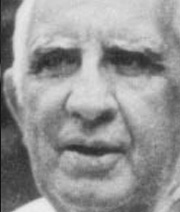Luis Feduchi
Madrid, 1901
Luis Martínez Feduchi Ruiz was born in 1901 in Madrid, within a family of architects, and following the tradition entered the School of Architecture in Madrid. After graduating, Feduchi traveled around Europe and got in touch with the latest architectural trends, from Expressionism to Rationalism or Art Déco. During his young years, Feduchi s uncle, architect Luis Cabello Lapiedra, instiled in his nephew the respect for monuments and a taste for popular and traditional architecture. This probably explains why throughout his professional career Feduchi undertook as many restoration...
Luis Martínez Feduchi Ruiz was born in 1901 in Madrid, within a family of architects, and following the tradition entered the School of Architecture in Madrid. After graduating, Feduchi traveled around Europe and got in touch with the latest architectural trends, from Expressionism to Rationalism or Art Déco. During his young years, Feduchi s uncle, architect Luis Cabello Lapiedra, instiled in his nephew the respect for monuments and a taste for popular and traditional architecture. This probably explains why throughout his professional career Feduchi undertook as many restoration projects. In fact, one of his first works consisted of the restoration and decoration of the Oropesa castle, that became the first Parador de Turismo in Spain (1932), and of two private livings, in el Plantío (1929) and in the Oquendo street in Madrid (1932). During the 30s, Feduchi was one of the architects that participated in the building project of the Gran Vía in Madrid, together with the most prestigious architects of the country: Castro Fernández Shaw, Luis Gutiérrez Soto, Modesto López de Otero, Pedro Muguruza, Joaquín and Julián Otamendi, Antonio Palacios, and Secundino Zuazo. The project had been approved in 1901, with an exorbitant budget for that time, almost 29 million pesetas. Although the it was supposed to be done by 1918, it was prolonged to 1929. Together with Vicente Eced, with whom he collaborated often, a friend and neighbor when they were children and a classmate in university, Feduchi carried out his most renown work, the Carrión building (the Capitol movies theater) in the Gran Vía (1933).Feduchi did not separate his architectural projects from his facet as an industrial designer, especially in the area of furniture design. After returning from his tour around Europe, he worked on several projects with Javier Feduchi, Javier Carvajal and Carlos de Miguel. Together, they fought to develop Spanish industrial design, but they faced major obstacles: the lack of an industrial structure and the fact that businessmen were not willing to take risk, made it hard to find new projects. In both of his major works, the Capitol building (1931-1933) and the Castellana Hilton hotel (1953), Feduchi designed a vast series of pieces of furniture, including even the cutlery, refrigerators and other electrical appliances. In the case of the Carrión building, he worked with the furniture firm ROLACO-MAC, and in 1934 the building was granted the Second Class Medal in the National Exhibition of Arts. Two years later, Feduchi and his friend Luis Santamaría founded the Sociedad Santamaría y Feduchi de Muebles y Decoración. At the same time, Feduchi worked as a curator architect of the Heritage of the Republic. After the Spanish Civil War, Feduchi was luckier than many of his colleagues (such as Vicente Eced), he was not imprisoned nor suspended. During the first postwar years he did the decoration for movie billboards, and taught Scenography and Decoration at the Cinematography School from 1946 to 1955. He also did projects for the Instituto de Cultura Hispánica and the Spanish Foreign Office, as well as private projects, such as the Museo de América (1942-1954), the Escuela Diplomática (1948-1954) of the Castellana Hotel (1947-1953). Feduchi came back to his modernist origins and to Spanish and Latinamerican traditional architecture. He also took over projects out of Madrid and abroad, such as in Almería, Huesca, Zaragoza, Ferrol, Vigo, Cáceres, or Tangier.
